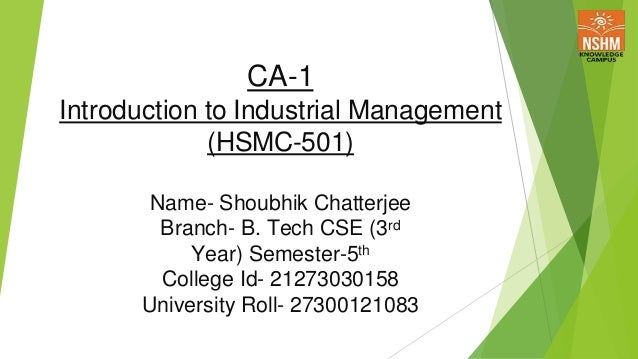IIM CA1_Shoubhik_Chatterjee_21273030158.pptx
•Download as PPTX, PDF•
0 likes•3 views
fl
Report
Share
Report
Share

Recommended
More Related Content
Featured
Featured (20)
Product Design Trends in 2024 | Teenage Engineerings

Product Design Trends in 2024 | Teenage Engineerings
How Race, Age and Gender Shape Attitudes Towards Mental Health

How Race, Age and Gender Shape Attitudes Towards Mental Health
AI Trends in Creative Operations 2024 by Artwork Flow.pdf

AI Trends in Creative Operations 2024 by Artwork Flow.pdf
Content Methodology: A Best Practices Report (Webinar)

Content Methodology: A Best Practices Report (Webinar)
How to Prepare For a Successful Job Search for 2024

How to Prepare For a Successful Job Search for 2024
Social Media Marketing Trends 2024 // The Global Indie Insights

Social Media Marketing Trends 2024 // The Global Indie Insights
Trends In Paid Search: Navigating The Digital Landscape In 2024

Trends In Paid Search: Navigating The Digital Landscape In 2024
5 Public speaking tips from TED - Visualized summary

5 Public speaking tips from TED - Visualized summary
Google's Just Not That Into You: Understanding Core Updates & Search Intent

Google's Just Not That Into You: Understanding Core Updates & Search Intent
The six step guide to practical project management

The six step guide to practical project management
Beginners Guide to TikTok for Search - Rachel Pearson - We are Tilt __ Bright...

Beginners Guide to TikTok for Search - Rachel Pearson - We are Tilt __ Bright...
IIM CA1_Shoubhik_Chatterjee_21273030158.pptx
- 1. CA-1 Introduction to Industrial Management (HSMC-501) Name- Shoubhik Chatterjee Branch- B. Tech CSE (3rd Year) Semester-5th College Id- 21273030158 University Roll- 27300121083
- 2. 1. What do you mean by Management? Give diagram and examples. There are many ways to construe what management is. Some of which are following- Management is a problem-solving process of effectively achieving organizational objectives through the efficient use of scarce resources in a changing environment. Management is an art of knowing what to do when to do and see that it is done in the best and cheapest way .
- 3. Management is a set of activities directed at the efficient and effective utilization of resources in the pursuit of one or more goals. working with human, financial and physical resources to achieve organizational objectives by performing the planning, organizing, leading.
- 4. Few examples of Management- Customer Feedback & Satisfaction Continuous Improvement Define Business Processes Management Responsibility Customer Focus Resource Management Service provision Monitor & Measure
- 5. 2.What are the different Functions of Management ? Give diagrams as well as examples Functions of Management- Planning and Decision Making - Planning is decision- making regarding the goals and setting the future course of action from a set of alternatives to reach them. Planning involves selecting missions and objectives and the actions to achieve them. It requires decision-making or choosing future courses of action from among alternatives.
- 6. Organizing – Coordinating Activities and Resources - Organizing involves determining how activities and resources are to be assembled and coordinated. Organizing produces a structure of relationships in an organization, and it is through these structured relationships, plans are pursued. Organizing is part of managing, which involves establishing an intentional structure of roles for people to fill in the organization. Leading – Managing, Motivating, and Directing People- The third basic managerial function is leading. It is the skills of influencing people for a particular purpose or reason. Leading is considered to be the most important and challenging of all managerial activities.
- 7. Controlling – Monitoring and Evaluating Activities – Controlling is measuring, comparing, finding deviation, and correcting the organizational activities performed to achieve the goals or objectives. Thus, controlling consists of activities like; measuring the performance, comparing with the existing standard and finding the deviations, and correcting the deviations. Monitoring the organizational progress toward goal fulfillment is called controlling. Thus, monitoring progress is essential to ensure the achievement of organizational goals.
- 9. Functions of management are a logical foundation on which you may rely in your professional life. Now that we’ve gone over each function in depth, let’s look at how they’re used in practice. The following are some examples of management functions: Assume you work as an operations manager for a company that manufactures office furniture. Your responsibilities will include defining manufacturing, packing, and delivery methods. You’ll need to keep an eye on the assembly line’s progress. This is to ensure that everything is up to code and that performance is not jeopardized at any moment.
- 10. As a manager, you must set clear production targets, hire the right people for your team, and track progress to avoid mistakes. Through achieve quality standards, you must collaborate with your team from the planning to the controlling stages. Assume you’re a sales manager tasked with selling a new product. Your responsibilities now include forming a new sales team for this project. This is where you assess talents and varied capabilities in order to appoint the right people. Someone proficient in mathematics, for example, may assist you in visualizing sales projections and developing budgets. Meanwhile, someone with good design skills can contribute to the product packaging and ad campaigns.